Data from the Greenhouse: Photosynthetic Efficiency – Part 2
In this article, we delve into nighttime photosynthetic efficiency, a value that is essential for the healthy growth of crops. Using data from MyLedgnd, we demonstrate what occurs during the night and how this impacts the crop and the greenhouse climate. We focus specifically on the period from January 8 to 11, during which we gained significant insights.
This article examines an example of nighttime photosynthetic efficiency at a Phalaenopsis grower.
In our column ‘Data from the Greenhouse,’ we showcase the possibilities of greenhouse data. Through practical examples, we explain how data analysis can provide deeper insights into your crop and climate. We also offer tools to help you analyze and interpret your own data independently.
Crop
Phalaenopsis
Season
Winter
Sensors
- Photosynthetic Efficiency sensor
- PAR-sensor
What is Photosynthetic Efficiency?
Photosynthetic efficiency indicates how effectively a plant can convert received light into sugars, the energy source it requires for growth. This process becomes especially critical during winter due to the limited availability of natural sunlight. The more efficiently the plant utilizes light, the better it can build biomass and store energy. In the greenhouse, lamps play a vital role as an alternative light source.
How is Photosynthetic Efficiency measured?
Photosynthetic efficiency can be measured using a photosynthetic efficiency sensor, which stimulates the plant with a light pulse and then measures the plant’s response in the form of chlorophyll fluorescence. This provides insights into how effectively the plant converts light into energy.
During the night, when no natural light is present, a light pulse is emitted every hour to measure photosynthetic efficiency. During the day, this measurement is conducted every five minutes.
What is Chlorophyll Fluorescence?
How Does the Plant Utilize Light?
A plant can handle light in three ways:
- The light is used for the production of sugars.
- It is converted into heat.
- It is reflected as fluorescent light.
The photosynthetic efficiency sensor uses this fluorescent response to calculate key photosynthesis parameters, such as Fv/Fm.
What is Fv/Fm?
Photosynthetic parameters such as Fv/Fm are metrics used to assess the efficiency of photosynthesis.
Fv/Fm is the ratio of variable fluorescence (Fv) to maximum fluorescence (Fm). It indicates how efficiently the plant’s photosystem II converts light energy into chemical energy.
A high Fv/Fm value (typically around 82% in healthy plants) signifies that the plant is effectively utilizing light energy for photosynthesis, while a low value may indicate stress or damage to the photosynthetic mechanism.
Photosynthetic parameters such as Fv/Fm are metrics used to assess the efficiency of photosynthesis.
Fv/Fm is the ratio of variable fluorescence (Fv) to maximum fluorescence (Fm). It indicates how efficiently the plant’s photosystem II converts light energy into chemical energy.
A high Fv/Fm value (typically around 82% in healthy plants) signifies that the plant is effectively utilizing light energy for photosynthesis, while a low value may indicate stress or damage to the photosynthetic mechanism.
Graph Analysis
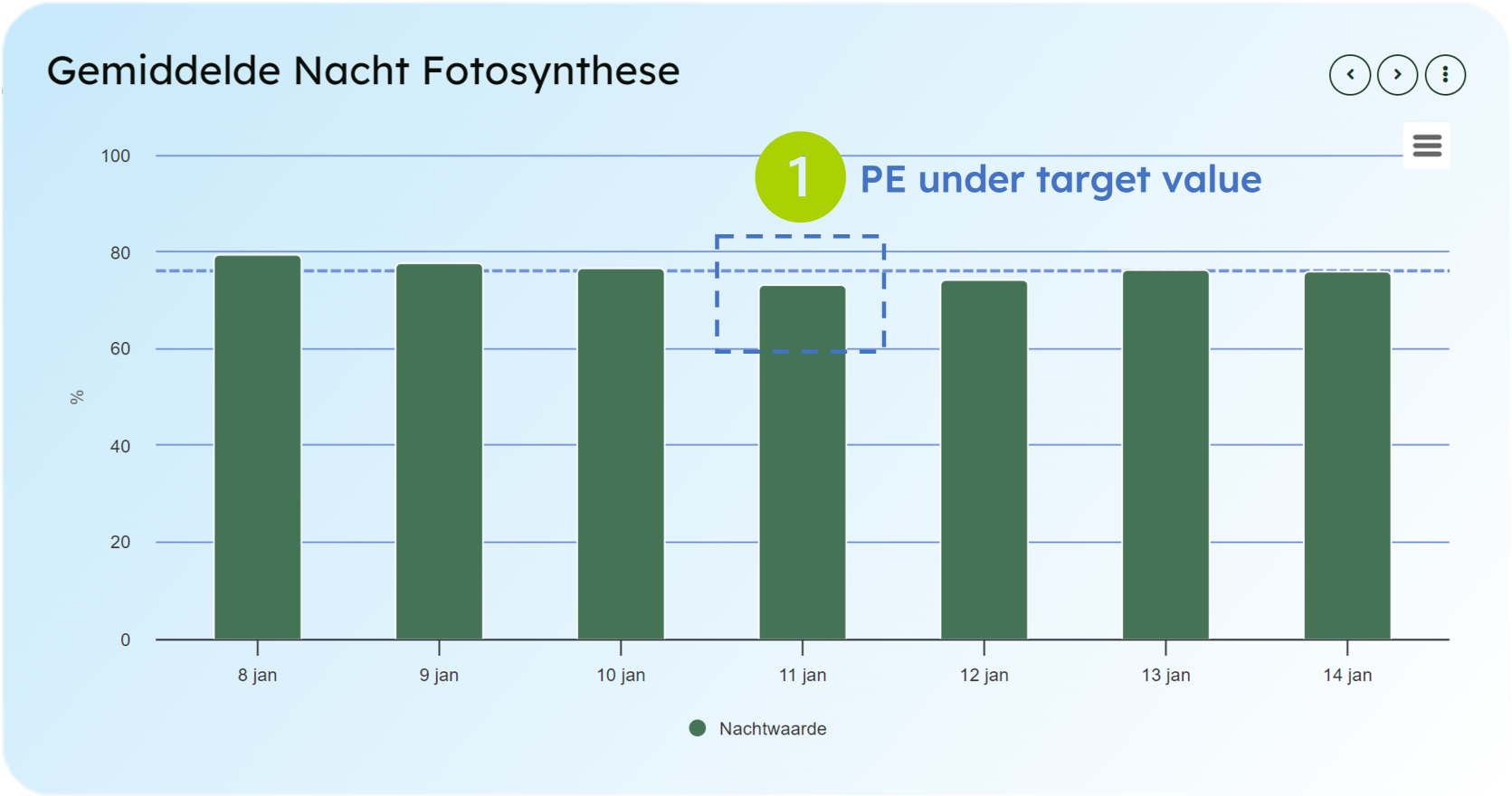
Graph 1
Damage
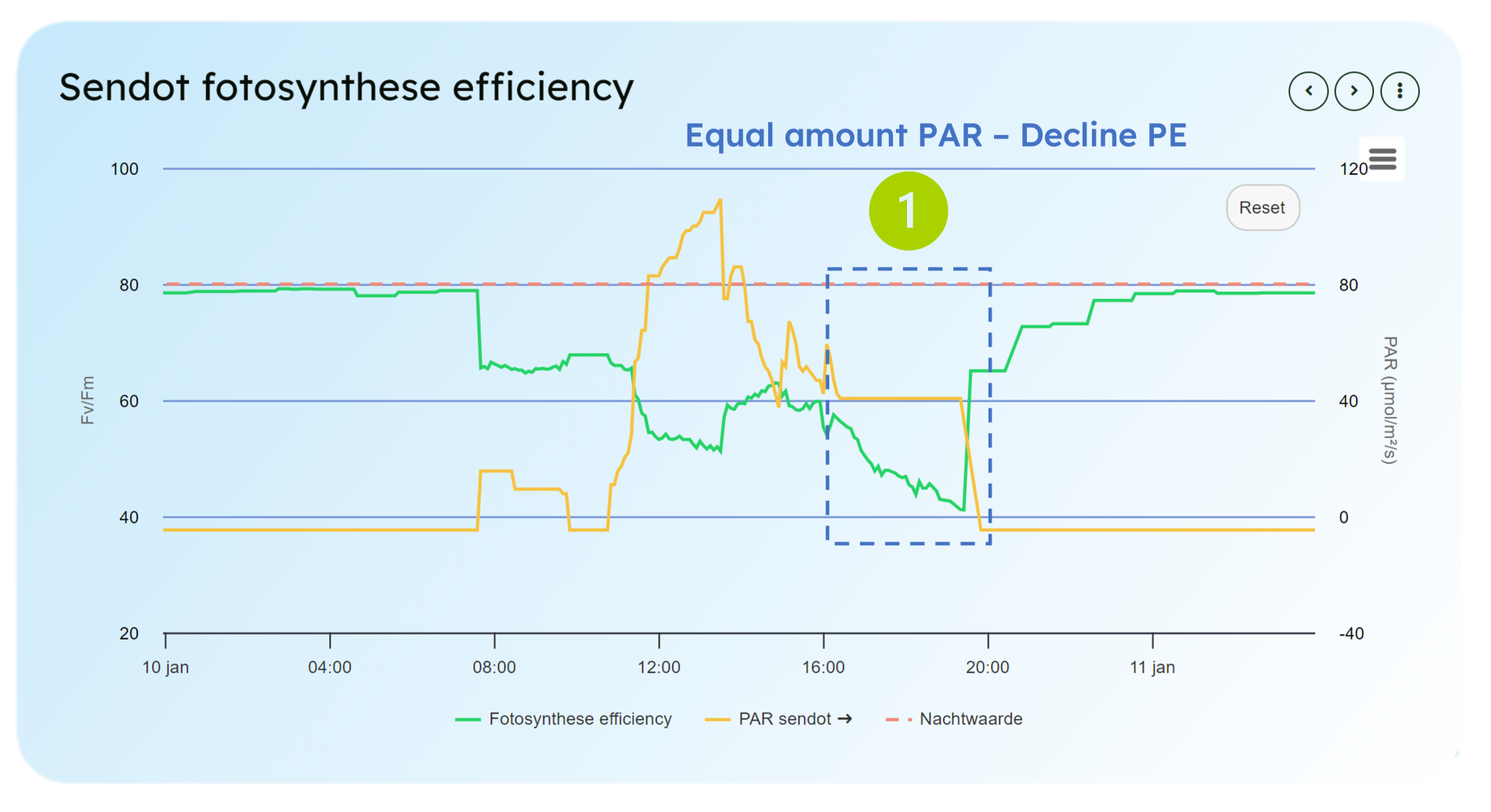
Graph 2
In the graph, we see that on January 10, starting at 4:00 p.m., photosynthetic efficiency begins to drop sharply (Graph 2, marker 1), even though light intensity remains constant. This suggests that the plant’s malate reserves are depleted. We discussed this situation in a previous article. Read the earlier Data from the Greenhouse article on Photosynthetic Efficiency in Phalaenopsis here.
Additionally, in the same graph below, we observe that it takes a long time for photosynthetic efficiency to approach the target value again (Graph 3, marker 1). The likely depletion of malate reserves makes it difficult for the plant to recover, causing it to sustain damage.
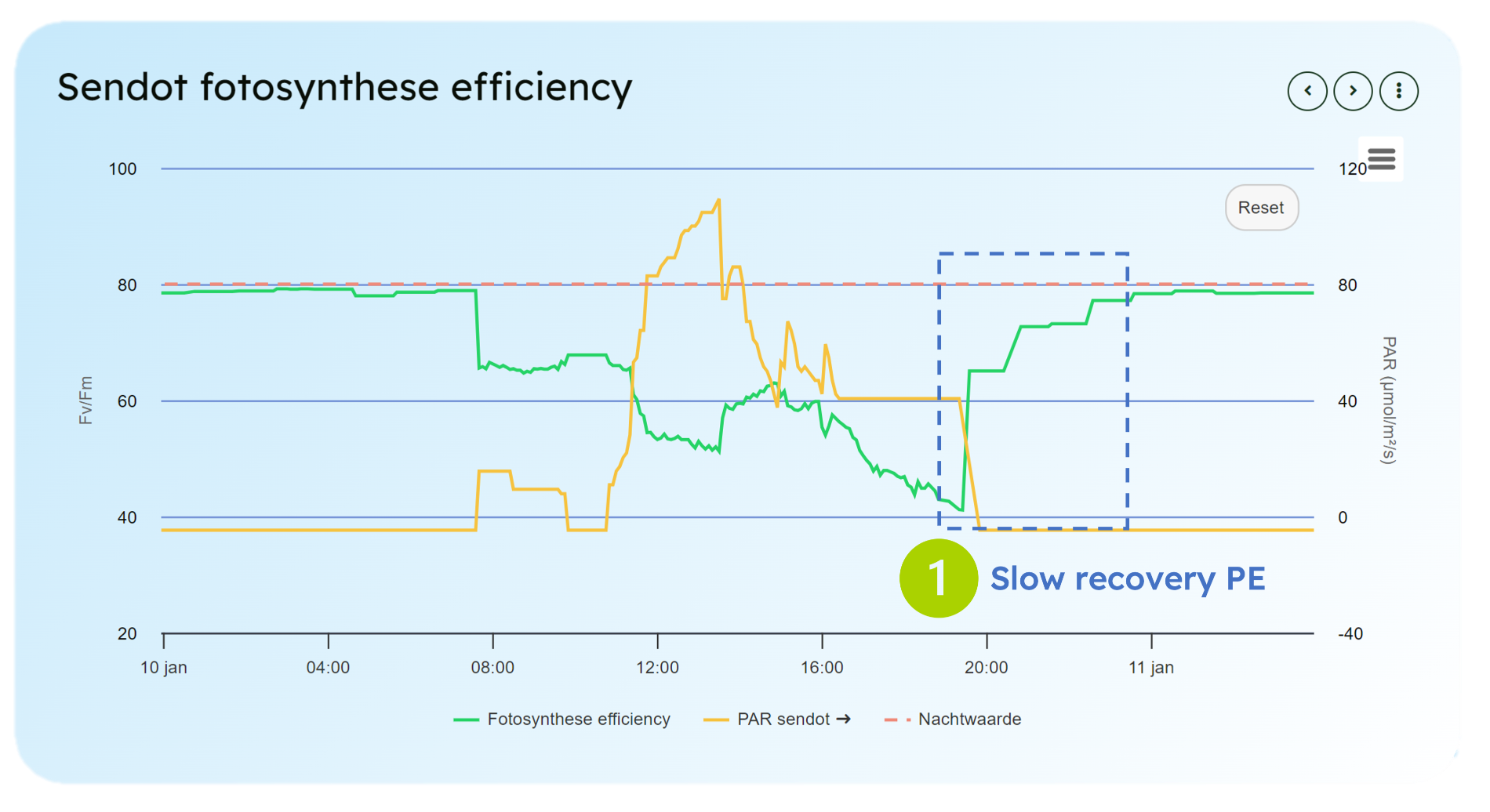
Graph 3
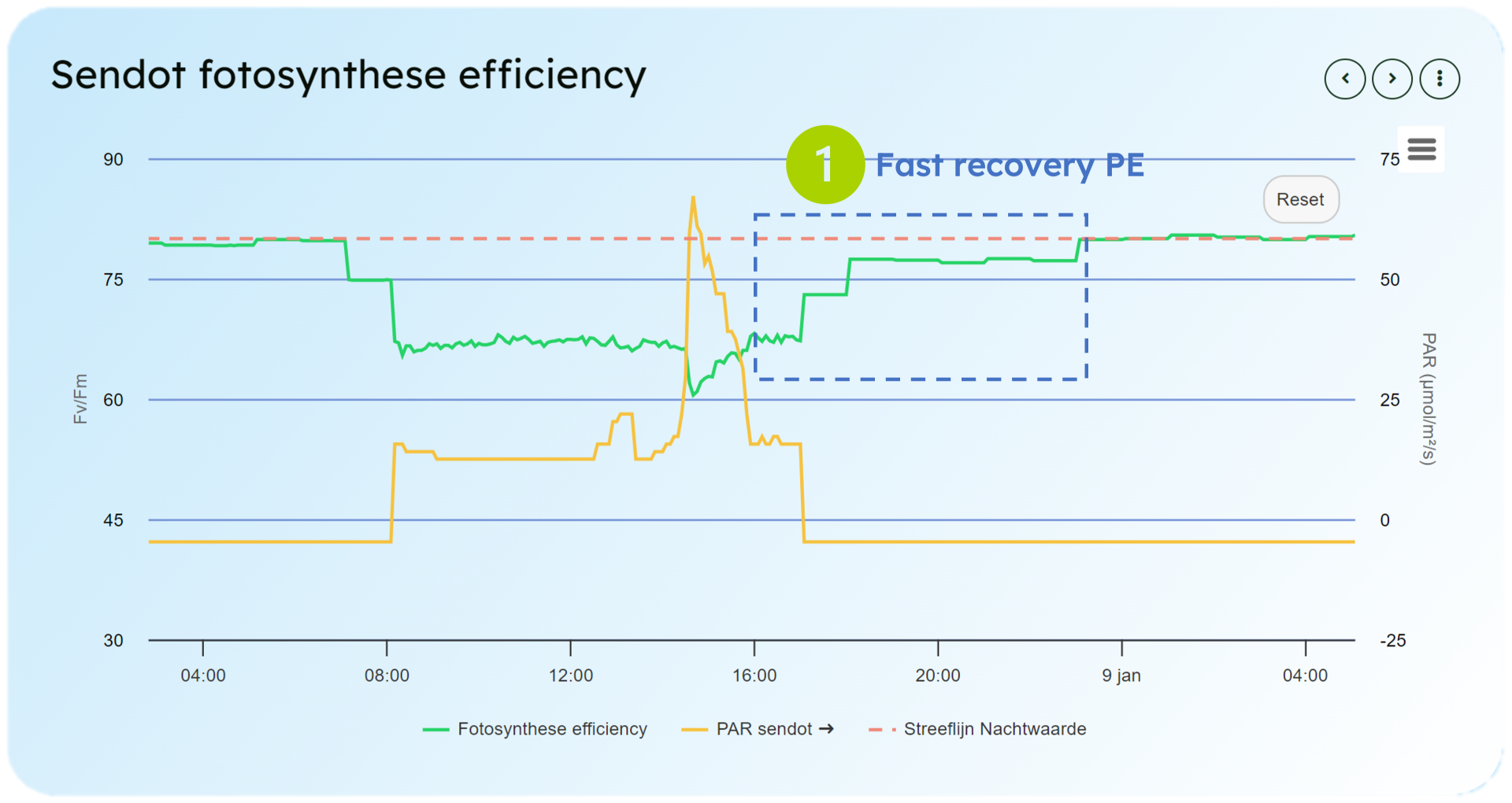
Graph 4
Preventing Damage
Conclusion
Closely monitoring and taking timely action are crucial to prevent crop damage. Use the right sensors, such as photosynthesis sensors (including PAR measurements), and the MyLedgnd data portal. By carefully tracking photosynthetic efficiency and acting proactively, we can ensure that the plant continues to perform optimally both during the day and at night. This approach supports stable growth and a healthy crop.
New articles
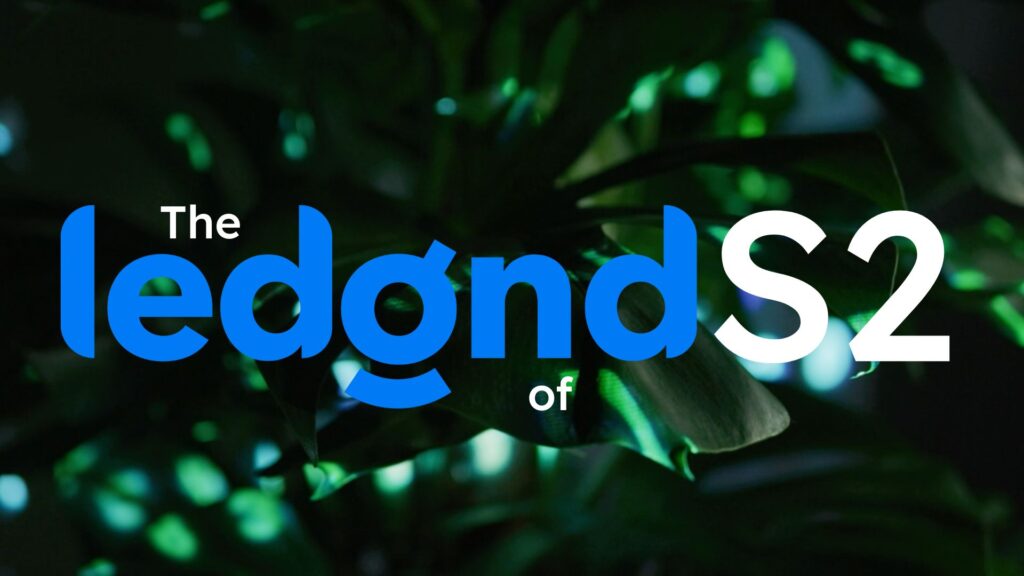
Ledgnd launches season 2 of video series “The Ledgnd of”
Ledgnd has launched the second season of its video series “The Ledgnd of”. The series takes a closer look at the key concepts and innovations shaping modern greenhouse horticulture. In the new season,…

Ledgnd at Hortibiz Next Level Data: From data to action
During the theme week “Next Level Data, Artificial Intelligence and Robotics” by Hortibiz News Radio, Ledgnd joined the table to talk about one key question: how do you turn all greenhouse data back i…

Duijvestijn, Ledgnd and Gavita International continue collaboration on LED optimization
Following the success of the first LED optimization trial at Duijvestijn Tomaten in Pijnacker, Duijvestijn, Ledgnd and Gavita International are launching a second research phase to be conducted over t…
Read more

Ledgnd launches season 2 of video series “The Ledgnd of”
Ledgnd has launched the second season of its video series “The Ledgnd of”. The series takes a closer look at the key concepts and innovations shaping modern greenhouse horticulture. In the new season,…

Ledgnd at Hortibiz Next Level Data: From data to action
During the theme week “Next Level Data, Artificial Intelligence and Robotics” by Hortibiz News Radio, Ledgnd joined the table to talk about one key question: how do you turn all greenhouse data back i…

Duijvestijn, Ledgnd and Gavita International continue collaboration on LED optimization
Following the success of the first LED optimization trial at Duijvestijn Tomaten in Pijnacker, Duijvestijn, Ledgnd and Gavita International are launching a second research phase to be conducted over t…
Do you want to know more?
Interested in what Ledgnd can do for you? Leave your phone number, and we will contact you as soon as possible for a non-binding informational conversation

